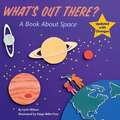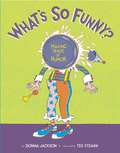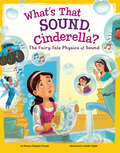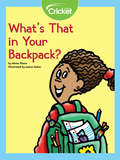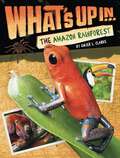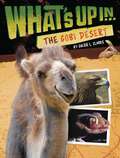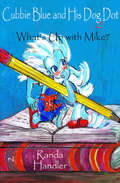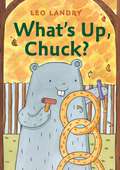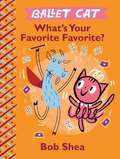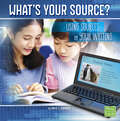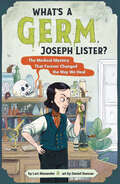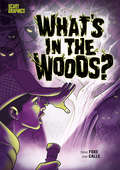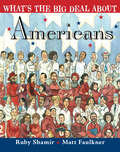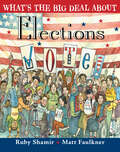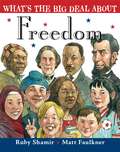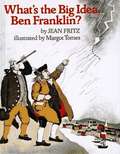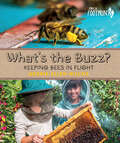- Table View
- List View
What's Out There? A Book About Space (Reading Railroad)
by Lynn WilsonWhat is the sun made of? What causes night and day? Why does the moon change shape? An easy-to-understand text bring planets, stars, comets, and the wondrous things out there in space right down to earth in a simple introduction to the solar system for young armchair astronauts.
What's Smaller Than a Pygmy Shrew?
by Robert E WellsA pygmy shrew is among the tiniest of mammals. A ladybug is even smaller. But in this book you will find small things you could not ordinarily see.
What's So Funny?
by Donna JacksonEveryone loves to laugh, and to hear and see funny things-but what makes something funny in the first place? What is humor? This book explains why our brains think something is funny, what happens to us physically when we laugh, why you can tickle your friend but not yourself, and so much more. Plenty of jokes and silly anecdotes are included, and hilarious line drawings appear on almost every page.
What's That Sound, Cinderella?: The Fairy-tale Physics Of Sound (Stem-twisted Fairy Tales Ser.)
by Thomas Kingsley TroupeThe stepsisters yell. The fairy godmother sings. The pineapple-turned-monster-truck burns rubber on its way to the ball. For Cinderella, this evening is an enchanted STEM adventure through the science of sound. For readers, it's a treat of a fractured fairy tale, complete with an ear diagram, a key-term glossary, critical thinking questions, and a sweet pair of glass high-top sneakers.
What's That in Your Backpack?
by Mona PeaseAre you carrying a forest on your back? Of course not! But if you dig through your backpack, you will probably find many things that come from the forest.
What's The Weather Today? (Rookie Read-about Science)
by Allan FowlerA simple explanation of weather and climate.
What's Up in the Amazon Rainforest (What's Up)
by Ginjer L. ClarkeWhere in the world will you find 427 different types of mammals, 1,294 birds, 2,200 fishes, 378 reptiles, 428 amphibians, and about 1 million insects? The Amazon Rainforest, of course! Get lost in the largest rainforest in the world to climb trees that are 500 years old, swim with a pink dolphin, avoid the deadly poison dart frogs, and sleep with a troop of twenty howler monkeys. In What's Up in the Amazon Rainforest, you'll learn all about the plants and animals, as well as the people that live there and the habitat itself.
What's Up in the Gobi Desert (What's Up)
by Ginjer L. ClarkeExplore the Gobi Desert with the second book in this nonfiction geography series, packed with full-color photographs and a fold-out map! Gobi means "waterless place" - the perfect name for a desert! The Gobi covers parts of northern China and southern Mongolia. But contrary to the typical desert image, only 5% of the Gobi has sand dunes! It is also very cold, with an average temperature of only 37 degrees Fahrenheit for the entire year. Explore the expanse of the Gobi Desert with this fascinating addition to the What's Up series, and discover the wild plants, animals, and people that call this habitat home.
What's Up with Mike?: Cubbie Blue And His Dog Dot Book 2 (Cubbie Blue and His Dog Dot #2)
by Randa HandlerDerek, Chris, and Brian, three seven-year-old boys, befriend Derek's new neighbor, Mike, who is blind. Their special friend, Cubbie Blue, a three-inch-tall being with supernatural powers, and his minuscule dog, Dot, help the boys learn about Mike's limitations and needs. This important knowledge allows them to properly welcome Mike to the neighborhood. In turn, the boys help Cubbie escape from the evil soldiers trying to capture him, and he is saved by their bravery.
What's Up, Chuck?
by Leo LandryA hilarious follow-up to Grin and Bear It, this early reader offers lessons on jealousy, self-confidence and the art of making new friends.Chuck Wood is upset. Jealous, too. Also insecure. As the winner of the Best of the Forest art contest three years in a row, he finds it very difficult to deal with the prospect that newcomer Scooter Possum&’s abstract paintings might beat his wood sculptures. But with the help of his forest friends, Chuck deals with his hurt feelings and realizes that his love for creating art is greater than his need to win. When you follow your heart, everyone&’s a winner.
What's Your Favorite Favorite (Ballet Cat)
by Bob SheaBallet Cat and her cousin, Goat, try to outdo one another while putting on a show for their grandmother.
What's Your Source?: Using Sources In Your Writing (All About Media Ser.)
by Brien J. Jenningsmedia studies; media literacy; types of media; internet safety; using sources; sources; analyze media; what's your source
What's a Germ, Joseph Lister?: The Medical Mystery That Forever Changed the Way We Heal
by Lori AlexanderThis engrossing, timely, and highly illustrated biography of the father of modern surgery reveals the shocking practices of surgeons before Joseph Lister proved where infections come from.In 1841, a quiet, curious boy who stuttered when nervous committed to becoming a surgeon—a profession then more feared than respected.Through study, persistence, and careful research, Joseph Lister proved that unsanitary conditions contribute to infections. Despite others scoffing at his ideas, Lister slowly changed the way all surgeons work, saving countless lives.Sibert Honor-winner Lori Alexander’s accessible and lively biography of Lister contains fun—and sometimes gory—facts about the history of science and engaging illustrations by Daniel Duncan.
What's for Lunch? (Let's-Read-and-Find-Out Science 1)
by Sarah L. ThomsonRead and find out about the different kinds of food we eat and how to fill up your plate to keep your body healthy in this colorfully illustrated nonfiction picture book.What's for lunch? Your body needs lots of different things to eat, and every kind of food has a different job to do. Did you know drinking milk makes your bones strong? Or that eating carrots helps you see better?This is a clear and appealing science book for early elementary age kids, both at home and in the classroom. It includes a find-out-more section with simple guides to learn about everyday healthy eating. Both text and artwork were vetted for accuracy by Dr. Carolyn Johnson, PhD, FAAHB, NCC, LPA, and Keelia O'Malley, MPH.This is a Level 1 Let's-Read-and-Find-Out, which means the book explores introductory concepts perfect for children in the primary grades. The 100+ titles in this leading nonfiction series are:hands-on and visualacclaimed and trustedgreat for classroomsTop 10 reasons to love LRFOs:Entertain and educate at the same timeHave appealing, child-centered topicsDevelopmentally appropriate for emerging readersFocused; answering questions instead of using survey approachEmploy engaging picture book quality illustrationsUse simple charts and graphics to improve visual literacy skillsFeature hands-on activities to engage young scientistsMeet national science education standardsWritten/illustrated by award-winning authors/illustrators & vetted by an expert in the fieldOver 130 titles in print, meeting a wide range of kids' scientific interestsBooks in this series support the Common Core Learning Standards, Next Generation Science Standards, and the Science, Technology, Engineering, and Math (STEM) standards. Let's-Read-and-Find-Out is the winner of the American Association for the Advancement of Science/Subaru Science Books & Films Prize for Outstanding Science Series.
What's in Your Pocket?: Collecting Nature's Treasures
by Heather L. MontgomeryCharles Darwin, George Washington Carver, and Jane Goodall were once curious kids with pockets full of treasures!When you find something strange and wonderful, do you put it in your pocket? Meet nine scientists who, as kids, explored the great outdoors and collected "treasures": seedpods, fossils, worms, and more. Observing, sorting, and classifying their finds taught these kids scientific skills--and sometimes led to groundbreaking discoveries. Author Heather Montgomery has all the science flair of a new Bill Nye. Book includes the Heather's tips for responsible collecting.
What's in the Woods? (Scary Graphics)
by Steve FoxeAndy isn't excited for camp. Things go downhill when the older boys start telling stories of mysterious fairy circles hidden in the ancient woods. If you disturb a circle, they say, you'll be snatched away forever by vicious creatures. Andy assumes it's a made-up tale to frighten newbies, but when he kicks over a circle made of stones and bones, he'll find out there may be some truth to the legends after all...In this Scary Graphics tale, easy-to-read text and eerie, full-color art combine to deliver just-right scares for kids who crave chills and thrills.
What's the BIG Idea?: Amazing Science Questions for the Curious Kid
by Vicki CobbWhy don't we feel the Earth move? Why does an ice cube float? Why can't you unscramble an egg? Why can't we live forever? These are all questions that a curious kid might ask. In What's the BIG Idea?, renowned juvenile science educator Vicki Cobb answers these and other fascinating questions to help kids learn more about the world through the wonders of science.A big idea is one that has no simple or easy answer, and there are four big ideas in this book: motion, energy, matter, and life. The motion of nonliving objects--rolling balls, falling stones, the moon and stars--seems so ordinary and familiar that most people take it for granted. Matter, on the other hand, comes in so many different forms--solids, liquids, gases, metals, nonmetals, living material--that it is hard to imagine anything that all matter has in common. Energy is an idea that is in the news just about every day, yet most people couldn't tell you what the big idea of energy is. And life--what life is--seems mind-boggling and infinitely complicated. How do we bend our brains around it?Scientists learn by asking questions. And this book, now in paperback, is designed to make young readers stop and think about each of the questions before reading what scientists have learned that answers each question. They'll be able to do simple things to see for themselves, and they will build their own scientific knowledge in the process. By the time they've finished this book, they'll get the big picture of what science is all about.
What's the Big Deal About Americans (What's The Big Deal About #4)
by Ruby ShamirFrom Native American traditions to immigrant inventions, from diversity to democracy, from ice cream cones to apple pie, this fun and fact-filled book--now in chapter book format!--celebrates the melting pot and mosaic that is America. A perfect way to start a conversation about America with young readers.Did you know that the inventor of American cheese actually came from Canada? Or that founding father Benjamin Franklin was inspired to create a democratic society by a confederacy of Native American tribes who came together to stop their constant warring? How about that both "God Bless America" and "White Christmas" were written by Irving Berlin, a Russian Jew who fled to the U.S. because of persecution back home?This entertaining, fact-filled book, perfect for fans of the Who Was series, is a great way to talk about the idea that people have come to America from many countries, in many ways, for many reasons. Americans have many different beliefs, different languages, and different traditions. But even with all of these differences, America comes together with the understanding that our country and government is "of the people, by the people, and for the people." And there's nothing more American than that.With full-color illustrations throughout and a timeline of American history and additional reading resources at the end, this book is a perfect introduction to the story of America.
What's the Big Deal About Elections (What's The Big Deal About)
by Ruby ShamirFrom campaigns to voting booths, from local elections to national races, this fun and fact-filled book--now in chapter book format!--celebrates the fundamental American idea that "we the people" get to decide who runs the show. A perfect way to start a conversation about American elections with young readers.Did you know that we have more than ninety thousand state and local governments in the US? Or that Election Day celebrations two hundred years ago featured marching bands and bonfires? How about that George Washington was our only president who ran unopposed?Elections allow adult citizens the chance to choose how our cities, states, and country are run. Even kids who can't vote yet can make their voices heard by helping the candidates they like get votes! Our elections can seem complicated, but at their core they're all about having a say in our own lives and future. In this fun and fact-filled chapter book, readers learn just how important being an active participant in our democracy can be through one simple message: Elections matter, and we can all play our part.This entertaining, fact-filled book, perfect for fans of the Who Was series, is a great way to talk about American elections and the fact that we all have a voice and a role to play.With full-color illustrations throughout and a timeline of American voting rights expansions and additional reading resources at the end, this book is a perfect introduction to the story of elections in America.
What's the Big Deal About First Ladies (What's The Big Deal About #1)
by Ruby ShamirFirst Ladies are more than just wives of U.S. presidents! This fun, kid-friendly book of trivia and history shows that First Ladies help influence America in ways both large and small.Did you know that Mary Todd Lincoln hated slavery and helped to end it in America? Or that Edith Wilson helped decode secret messages during World War I? How about that Sarah Polk didn&’t let anyone dance in the White House while she was first lady? It&’s true! In addition to being hostesses, advocates, ambassadors, activists, patriots, and role-models, each first lady put her own stamp on the White House—and on our country. In this fun-filled, fact-filled book, you can find out just what made each first lady unique and why they were so important. As it turns out, first ladies are a pretty big deal after all! This book is perfect for fans of So You Want to be President? and Rad American Women from A-Z:Rebels, Trailbalzers, and Visionaries who Shaped Our History...And Our Future, and is a great entry point to discussing elections, inaugurations, and all aspects of the White House with children.Praise for What's the Big Deal About First Ladies:★ "A breezy way to, as Abigail Adams urged, 'remember the ladies.'" --Kirkus Reviews, starred review"This title does an excellent job of highlighting the important roles that these women played throughout history....A delightful introduction to America&’s first ladies for elementary U.S. history collections." --School Library Journal "Packed with interesting facts and illustrated with style, this upbeat overview of America&’s First Ladies will entertain kids intrigued by history." --Booklist
What's the Big Deal About Freedom (What's The Big Deal About #2)
by Ruby ShamirFrom the Constitution to civil rights, from women's rights to the four freedoms, this kid-friendly picture book filled with fun facts and historical trivia shows how America got the nickname "land of the free."It&’s a &“free country&”! Why? Because in America we're free speak our minds, choose our leaders and set the rules. Since way back when Thomas Jefferson wrote the Declaration of Independence, Americans have stood up for freedom again and again – but it wasn&’t always easy! Did you know that Henry &“Box&” Brown escaped slavery by shipping himself north in a box? Or that Susan B. Anthony was arrested when she tried to vote? Did you know that even young kids protested for the right to go to school? This entertaining, fact-filled book celebrates how, with every generation, more and more Americans won the right to be free. Find out how they did it and why standing up for the &“land of the free&” is such a big deal!Perfect for fans of The One and Only Declaration of Independence, John, Paul, George & Ben, and Shh! We're Writing the Constitution – and a great way to talk about America, its values, and the rights we all enjoy.Praise for What's the Big Deal About Freedom:"Bolstering the upbeat tone of the writing while emphasizing the racial and religious diversity of Americans, the lively watercolor-and-pencil illustrations are consistently engaging and occasionally endearing. A hopeful, idealistic portrayal of freedom in America." --Booklist"An effective place for children to begin learning about the concept of freedom." --School Library Journal
What's the Big Idea, Ben Franklin?
by Jean FritzA brief biography of the eighteenth-century printer, inventor, and statesman who played an influential role in the early history of the United States.
What's the Buzz?: Keeping Bees in Flight (Orca Footprints #7)
by Merrie-Ellen WilcoxWhether they live alone or together, in a hive or in a hole in the ground, bees do some of the most important work on the planet: pollinating plants. What's the Buzz? celebrates the magic of bees--from swarming to dancing to making honey--and encourages readers to do their part to keep the hives alive. All over the world, bee colonies are dwindling, but everyone can do something to help save the bees, from buying local honey to growing a bee-friendly garden.
